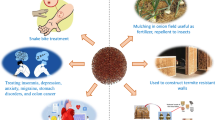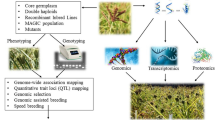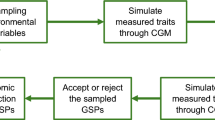Abstract
Key message
Exploiting the benefits from multiple-trait genomic selection for protein content prediction relying on additional grain yield information within training sets is a realistic genomic selection approach in rye breeding.
Abstract
Multiple-trait genomic selection (MTGS) was specially designed to benefit from the information of genetically correlated indicator traits in order to improve genomic prediction accuracies. Two segregating F3:4 rye testcross populations genotyped using diversity array technology markers and evaluated for grain yield (GY) and protein content (PC) were considered. The aims of our study were to explore the benefits of MTGS over single-trait genomic selection (STGS) for GY and PC prediction and to apply GS to predict different selection indices (SIs) for GY and PC improvement. Our results using a two-trait model (2TGS) empirically confirm that the ideal scenario to exploit the benefits of MTGS would be when the predictions of a relatively low heritable target trait with scarce phenotypic records are supported by an intensively phenotyped genetically correlated indicator trait which has higher heritability. This ideal scenario is expected for PC in practice. According to our GS implementation, MTGS can be performed in order to achieve more cycles of selection by unit of time. If the aim is to exclusively improve the prediction accuracy of a scarcely phenotyped trait, 2TGS will be a more accurate approach than a three-trait model which incorporates an additional correlated indicator trait. In general for balanced phenotypic information, we recommend to perform GS considering SIs as single traits, this method being a simple, direct and efficient way of prediction.



Similar content being viewed by others
Abbreviations
- 2T:
-
Two-trait
- 3T:
-
Three-trait
- 2TGS:
-
Two-trait genomic selection
- 3TGS:
-
Three-trait genomic selection
- BLUE(s):
-
Best linear unbiased estimator(s)
- BLUP(s):
-
Best linear unbiased predictor(s)
- CMS:
-
Cytoplasmic-male sterile
- DArT:
-
Diversity array technology
- GEBV(s):
-
Genomic predicted breeding value(s)
- GS:
-
Genomic selection
- GY:
-
Grain yield
- MT:
-
Multiple-trait
- MTGS:
-
Multiple-trait genomic selection
- NIRS:
-
Near-infrared reflectance spectroscopy
- O-SI:
-
Smith–Hazel or optimum selection index
- PC:
-
Protein content
- QTL:
-
Quantitative trait loci
- REML:
-
Restricted maximum likelihood
- RD:
-
Rogers’ distance
- R-SI:
-
Restricted selection index
- SDS:
-
Sudden death syndrome
- SEW:
-
Single ear weight
- SI:
-
Selection index
- ST:
-
Single-trait
- STGS:
-
Single-trait genomic selection
References
Albrecht T, Wimmer V, Auinger HJ, Erbe M, Knaak C, Ouzunova M, Simianer H, Schön CC (2011) Genome-based prediction of testcross values in maize. Theor Appl Genet 123:339–350
Bao Y, Kurle JE, Anderson G, Yong ND (2015) Association mapping and genomic prediction for resistance to sudden death syndrome in early maturing soybean germplasm. Mol Breed 35:128
Bauer A, Léon J (2008) Multiple-trait breeding values for parental selection in self-pollinating crops. Theor Appl Genet 116:235–242
Bernardo RN (2010) Breeding for quantitative traits in plants. Stemma Press, Woodbury
Butler DG, Cullis BR, Gilmour AR, Gogel B (2009) ASReml-R reference manual. The State of Queensland, Department of Primary Industries and Fisheries, Brisbane
Calus MPL, Veerkamp RF (2011) Accuracy of multi-trait genomic selection using different methods. Genet Sel Evol 43:26
Cerón-Rojas JJ, Sahagún-Castellanos J, Castillo-González F, Santacruz-Varela A, Crossa J (2008) A restricted selection index method based on eigenanalysis. J Agric Biol Environ Stat 13:440–457
Christensen OF, Madsen P, Nielsen B, Ostersen T, Su G (2012) Single-step methods for genomic evaluation in pigs. Animal 6:1565–1571
Crossa J, de Los Campos G, Pérez P, Gianola D, Burgueño J, Araus JL, Makumbi D, Singh RP, Dreisigacker S, Yan J, Arief V, Banziger M, Braun HJ (2010) Prediction of genetic values of quantitative traits in plant breeding using pedigree and molecular markers. Genetics 186:713–724
Dekkers JCM (2007) Prediction of response to marker-assisted and genomic selection using selection index theory. J Anim Breed Genet 124:331–341
Dolan DJ, Stuthman DD, Kolb FL, Hewings AD (1996) Multiple trait selection in a recurrent selection population in oat (Avena sativa L.). Crop Sci 36:1207–1211
Eagles HA, Frey KJ (1974) Expected and actual gains in economic value of oat lines from five selection methods. Crop Sci 14:861–864
Elgin JH, Hill RR, Zeiders KE (1970) Comparison of four methods of multiple trait selection for five traits in alfalfa. Crop Sci 10:190–193
Endelman JB, Atlin GN, Beyene Y, Semagn K, Zhang X, Sorrells ME, Jannink J-L (2013) Optimal design of preliminary yield trials with genome-wide markers. Crop Sci 54:48–59
Falconer DS, MacKay TFC (1996) Introduction to quantitative genetics, 4th edn. Ronald Press Company, New York
Guo G, Zhao F, Wang Y, Zhang Y, Du L, Su G (2014) Comparison of single-trait and multiple-trait genomic prediction models. BMC Genet 15:30
Hayashi T, Iwata H (2013) A Bayesian method and its variational approximation for prediction of genomic breeding values in multiple traits. BMC Bioinformatics 14:34
Hazel LN (1943) The genetic basis for constructing selection indexes. Genetics 28:476–490
Hazel LN, Lush JL (1942) The efficiency of three methods of selection. J Hered 33:393–399
Heffner EL, Jannink JL, Iwata H, Souza E, Sorrells ME (2011) Genomic selection accuracy for grain quality traits in biparental wheat populations. Crop Sci 51:2597–2606
Henderson CR (1975) Best linear unbiased estimation and prediction under a selection model. Biometrics 31:423–447
Henderson CR, Quass RL (1976) Multiple trait evaluation using relatives’ records. J Anim Sci 43:1188–1197
Heslot N, Yang HP, Sorrells ME, Jannink JL (2012) Genomic selection in plant breeding: a comparison of models. Crop Sci 52:146–160
Hofheinz N, Borchardt D, Weissleder K, Frisch M (2012) Genome-based prediction of test cross performance in two subsequent breeding cycles. Theor Appl Genet 125:1639–1645
Holbrook CC, Burton JW, Carter TE (1989) Evaluation of recurrent restricted index selection for increasing yield while holding seed protein constant in soybean. Crop Sci 29:324–329
Hübner M, Wilde P, Schmiedchen B, Dopierala P, Gowda M, Reif JC, Miedaner T (2013) Hybrid rye performance under natural drought stress in Europe. Theor Appl Genet 126:475–482
Jarquín D, Kocak K, Posadas L, Hyma K, Jedlicka J, Graef G, Lorenz A (2014) Genotyping by sequencing for genomic prediction in a soybean breeding population. BMC Genomics 15:740
Jia Y, Jannink JL (2012) Multiple-trait genomic selection methods increase genetic value prediction accuracy. Genetics 192:1513–1522
Kempthorne O, Nordskog AW (1959) Restricted selection indices. Biometrics 15:10–19
Kindred DR, Verhoeven TMO, Weightman RM, Swanston JS, Agu RC, Brosnan JM, Sylvester-Bradley R (2008) Effects of variety and fertiliser nitrogen on alcohol yield, grain yield, starch and protein content, and protein composition of winter wheat. J Cereal Sci 48:46–57
Lin C, Allaire F (1977) Heritability of a linear combination of traits. Theor Appl Genet 51:1–3
Liu T, Qu H, Luo C, Li X, Shu D, Lund MS, Su G (2014) Genomic selection for the improvement of antibody response to newcastle disease and avian influenza virus in chickens. PLoS One. doi:10.1371/journal.pone.0112685
Longin CFH, Mi X, Würschum T (2015) Genomic selection in wheat: optimum allocation of test resources and comparison of breeding strategies for line and hybrid breeding. Theor Appl Genet 128:1297–1306
Meuwissen THE (2009) Accuracy of breeding values of ‘unrelated’ individuals predicted by dense SNP genotyping. Genet Sel Evol 41:35
Meuwissen THE, Hayes BJ, Goddard ME (2001) Prediction of total genetic value using genome-wide dense marker maps. Genetics 157:1819–1829
Miedaner T, Hübner M, Korzun V, Schmiedchen B, Bauer E, Haseneyer G, Wilde P, Reif JC (2012) Genetic architecture of complex agronomic traits examined in two testcross populations of rye (Secale cereale L.). BMC Genomics 13:706
Openshaw SJ, Hadley HH (1984) Selection indexes to modify protein concentration of soybean seeds. Crop Sci 24:1–4
Perez C, Juliano BO, Liboon SP, Alcantara JM, Cassman KG (1996) Effects of late nitrogen fertilizer application on head rice yield, protein content, and grain quality of rice. Cereal Chem 73:556–560
Piepho HP, Möhring J (2007) Computing heritability and selection response from unbalanced plant breeding trials. Genetics 177:1881–1888
Pinto RJB, Alvarez JB, Martínet LM (2002) Preliminary evaluation of grain yield components in hexaploid tritordeum. Crop Breed Appl Biotechnol 2:213–218
R Core Team (2014) R: A language and environment for statistical computing. R Foundation for Statistical Computing, Vienna, Austria. ISBN 3-900051-07-0. http://www.R-project.org
Reif JC, Hamrit S, Heckenberger M, Schipprack W, Maurer HP, Bohn M, Melchinger AE (2005) Trends in genetic diversity among European maize cultivars and their parental components during the past 50 years. Theor Appl Genet 111:838–845
Rutkoski J, Benson J, Jia Y, Brown-Guedira G, Jannink JL, Sorrells ME (2012) Evaluation of genomic prediction methods for Fusarium head blight resistance in wheat. Plant Genome 5:51–61
Searle SR (1982) Matrix algebra useful for statistics. Wiley, New York
Shu Y, Yu D, Wang D, Bai X, Zhu Y, Guo C (2013) Genomic selection of seed weight based on low-density SCAR markers in soybean. Genet Mol Res 12:2178–2188
Smith HF (1936) A discriminant function for plant selection. Ann Eugen 7:240–250
Solberg TR, Sonesson AK, Woolliams JA, Meuwissen T (2008) Genomic selection using different marker types and densities. J Anim Sci 86:2447–2454
Spindel J, Begum H, Akdemir D, Virk P, Collard B, Redoña E, Atlin G, Jannink JL, McCouch SR (2015) Genomic selection and association mapping in rice (Oryza sativa): effect of trait genetic architecture, training population composition, marker number and statistical model on accuracy of rice genomic selection in elite, tropical rice breeding lines. PLoS Genet. doi:10.1371/journal.pgen.1004982
Suwantaradon K, Eberhart SA, Mock JJ, Owens JC, Guthrie WD (1975) Index selection for several agronomic traits in the BSSS2 maize population. Crop Sci 15:827–833
Tsuruta S, Misztal I, Aguilar I, Lawlor TJ (2011) Multiple-trait genomic evaluation of linear type traits using genomic and phenotypic data in US Holsteins. J Dairy Sci 94:4198–4204
Wang Y, Mette MF, Miedaner T, Gottwald M, Wilde P, Reif JC, Zhao Y (2014) The accuracy of prediction of genomic selection in elite hybrid rye populations surpasses the accuracy of marker-assisted selection and is equally augmented by multiple field evaluation locations and test years. BMC Genomics 15:556
Wang Y, Mette MF, Miedaner T, Wilde P, Reif JC, Zhao Y (2015) First insights into the genotype–phenotype map of phenotypic stability in rye. J Exp Bot 66:3275–3284
Williams JS (1962) The evaluation of a selection index. Biometrics 18:375–393
Windhausen VS, Atlin GN, Hickey JM, Crossa J, Jannink JL, Sorrells ME, Raman B, Cairns JE, Tarekegne A, Semagn K, Beyene Y, Grudloyma P, Technow F, Riedelsheimer C, Melchinger AE (2012) Effectiveness of genomic prediction of maize hybrid performance in different breeding populations and environments. G3 Genes| Genomes| Genetics 2:1427–1436
Yoshira T, Karasawa T, Nakatsuka K (2000) Yielding ability of winter triticale in a heavy snow area of central Hokkaido. Crop Breed Appl Biotechnol 2:213–218
Zhao Y, Gowda M, Liu W, Würschum T, Maurer HP, Longin FH, Ranc N, Reif JC (2012) Accuracy of genomic selection in European maize elite breeding populations. Theor Appl Genet 124:769–776
Acknowledgments
This research was conducted within the project “Erweiterung der genetischen Basis von Hybridroggen für Korn- und Biomasseleistung sowie Trockenheitstoleranz mittels Mehrlinienkartierung und DH-Technik” financially supported by the German Federal Ministry of Food and Agriculture via the “Fachagentur Nachwachsende Rohstoffe e.V.”, Gülzow, Germany (Grant ID: 22021711).
Author information
Authors and Affiliations
Corresponding author
Ethics declarations
Conflict of interest
The authors declare that they have no conflict of interest.
Ethical statement
The experiments were performed according to the current laws of Germany.
Additional information
Communicated by J. Wang.
A. W. Schulthess and Y. Wang equally contributed to this work.
Electronic supplementary material
Below is the link to the electronic supplementary material.
Rights and permissions
About this article
Cite this article
Schulthess, A.W., Wang, Y., Miedaner, T. et al. Multiple-trait- and selection indices-genomic predictions for grain yield and protein content in rye for feeding purposes. Theor Appl Genet 129, 273–287 (2016). https://doi.org/10.1007/s00122-015-2626-6
Received:
Accepted:
Published:
Issue Date:
DOI: https://doi.org/10.1007/s00122-015-2626-6




